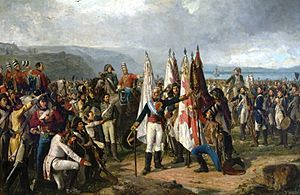Pedro Caro y Sureda, Marquis of La Romana facts for kids
Quick facts for kids
Pedro Caro Sureda
|
|
|---|---|

3rd Marquis de La Romana, wearing the uniform of a captain general, with the Grand Cross and band of Order of Charles III and an unidentified decoration (possibly foreign)
|
|
| Born | 2 October 1761 Palma de Mallorca |
| Died | 23 January 1811 (aged 49) Cartaxo, Portugal |
| Allegiance | |
| Battles/wars | Peninsular War |
Pedro Caro Sureda, 3rd Marquis of La Romana (1761–1811), was a brave Spanish military leader. He fought with great skill in two important wars: the French Revolutionary Wars and the Peninsular War. His younger brother, José Caro Sureda, was also a military leader, briefly serving as captain general of Valencia.
Contents
A Life of Service: Pedro Caro Sureda
Early Years and Military Training
Pedro Caro Sureda was born in Palma de Mallorca, a city on one of the Balearic Islands. His family was part of the nobility. He went to school in Lyon, France, where he learned a lot. He studied Greek and Latin, and he could speak French and English very well. Later, he attended a special school for nobles in Madrid and then the University of Salamanca.
Like many Spanish officers of his time, La Romana served in the American Revolutionary War when he was young. He joined the military academy in 1775. By 1791, he had become a frigate captain. He fought in battles at Minorca in 1781 and at Gibraltar in 1782.
In 1793, La Romana joined the Infantry Regiment "Inmemorial del Rey" No. 1. He served under his uncle, General Ventura Caro. He fought in the War of the Pyrenees, which was part of the War of the First Coalition. For his bravery, he was promoted to field marshal in 1794.
After this, he moved to the Army of Catalonia. He served under different commanders, including Luis Firmín de Carvajal, Conde de la Unión. After Carvajal died in battle, La Romana served under Urrutia.
In 1795, the Peace of Basel was signed, ending the war. Because of his excellent service, La Romana was promoted to lieutenant general. In 1800, he became the Captain General of Catalonia, a very important military position.
In 1807, King Charles IV was pressured by Napoleon. He agreed to send a group of experienced Spanish soldiers to join the French army in Germany. La Romana was chosen to lead this group, called the Division of the North. For about a year, in 1807 and 1808, his division was stationed in Hamburg and later in Denmark. They performed guard duties under Marshal Bernadotte.
Fighting in the Peninsular War
When the Peninsular War began, La Romana secretly planned with the British. He wanted to bring his soldiers back to Spain to fight against France. He was very clever and resourceful, and his plan worked! About 9,000 of his 15,000 men were able to board British ships on August 27, 1808, and escape to Spain. This move weakened Napoleon's army in the north.
La Romana arrived in Santander and was given command of the Army of Galicia on November 11. However, this army had just been defeated in battle. By November 26, La Romana took charge of what was left of the army, which was about 6,000 men.
With this smaller force, he fought some important battles to protect General Moore's army as they retreated west to Corunna. In 1809, La Romana led small attacks against the French. These attacks were successful. His men managed to distract the French and defeat isolated French groups, like at Villafranca.
After the French were defeated at Puente Sanpayo on June 6, Marshal Soult gave up trying to control Galicia. When Soult moved his forces towards the Portuguese border, La Romana also drove the French out of Asturias.
La Romana was appointed to the Central Junta on August 29, 1809, and served there until 1810. He then returned to military operations, working with Wellington. Sadly, he died suddenly on January 23, 1811, while preparing to help the city of Badajoz. Wellington greatly trusted and respected La Romana, more than almost any other Spanish general. When he heard of La Romana's death, Wellington wrote that it was "the greatest loss which the cause could sustain."
He is also known for being the driving force behind building the castle at Bendinat.
See also
 In Spanish: Pedro Caro y Sureda para niños
In Spanish: Pedro Caro y Sureda para niños
- Marquisate of La Romana


